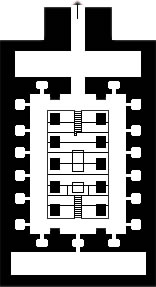Osireion
Da Ufopedia.
(Differenze fra le revisioni)
(→Galleria immagini) |
|||
| Riga 2: | Riga 2: | ||
[[Image:Plano Osireion.jpg|200px|thumb|right|The Osirion at the rear of the temple of [[Seti I]] at [[Abydos, Egypt|Abydos]]]] | [[Image:Plano Osireion.jpg|200px|thumb|right|The Osirion at the rear of the temple of [[Seti I]] at [[Abydos, Egypt|Abydos]]]] | ||
| - | The '''Osirion''' or '''Osireon''' is located at [[ | + | The '''Osirion''' or '''Osireon''' is located at [[Abydos]] at the rear of the temple of [[Seti I]]. It is an integral part of Seti I's funeral complex and is built to resemble an 18th Dynasty Valley of the Kings tomb. <ref>{{cite book | last = Bard| first = Katheryn |title = Encyclopedia of the Archaeology of Ancient Egypt | publisher = Routledge | year = 1999| isbn = 0-4151-8589-0}} p114</ref> It was discovered by archaeologists [[Flinders Petrie]] and [[Margaret Murray]] who were excavating the site in 1902-3. The Osirion was originally built at a considerably lower level than the foundations of the temple of Seti, who ruled from [[1294 BC|1294]] - [[1279 BC|1279]] BC <ref>{{cite book|author=Rice, Michael|title=Who's Who in Ancient Egypt|publisher=Routledge|date=1999}}</ref>. Peter Brand says it "can be dated confidently to Seti's reign".<ref>Brand, Peter J. ''The Monuments of Seti I: Epigraphic, Historical and Art Historical Analysis '' Brill September 2000, |
ISBN 978-9004117709 p. 175 [http://books.google.co.uk/books?id=5UZLNtTtEMkC&pg=PA174&dq=osireion+granite&num=100#PPA174,M1]</ref> | ISBN 978-9004117709 p. 175 [http://books.google.co.uk/books?id=5UZLNtTtEMkC&pg=PA174&dq=osireion+granite&num=100#PPA174,M1]</ref> | ||
Versione delle 11:53, 18 lug 2012
| Questa voce ha bisogno di essere tradotta. |
The Osirion or Osireon is located at Abydos at the rear of the temple of Seti I. It is an integral part of Seti I's funeral complex and is built to resemble an 18th Dynasty Valley of the Kings tomb. [1] It was discovered by archaeologists Flinders Petrie and Margaret Murray who were excavating the site in 1902-3. The Osirion was originally built at a considerably lower level than the foundations of the temple of Seti, who ruled from 1294 - 1279 BC [2]. Peter Brand says it "can be dated confidently to Seti's reign".[3]
Indice |
See also
Galleria immagini
Notes
- ↑ Template:Cite book p114
- ↑ Template:Cite book
- ↑ Brand, Peter J. The Monuments of Seti I: Epigraphic, Historical and Art Historical Analysis Brill September 2000, ISBN 978-9004117709 p. 175 [1]
External links
- The Osirion The original notes by archeologist Sir William Flinders-Petrie on the discovery of the Osirion site, publishd in 1903.
References
- Amélineau, E. C. Le Tombeau d´Osiris. Paris, 1899.
- Frankfort, H., De Buck, A. & Gunn, B. The Cenotaph of Seti I at Abydos, 2 vol. Memoir of the Egypt Exploration Society, Egypt Exploration Society. London, 1933.
- Murray, Margaret A. The Osirion at Abydos, British School of Egyptian Archeology n°1, London, 1904.

